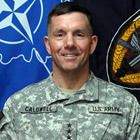"a soldier interacting, without mediation"


Engagement
Kairos: You described your frustration as Spokesman for MNF-I when you saw "not only the power of the new media in the form of the internet and YouTube videos, but. . . also. . . how adeptly the enemy was leveraging that power" and yet had to cut through considerable "bureaucratic red tape" in order to post your own YouTube videos, and even then—despite being a two-star general—you couldn't actually view the videos (Caldwell, 2008b). According to the Web site Wired, a memorandum on May 18, 2009, "from the Army's 93rd Signal Brigade to all domestic Directors of Information Management, or DOIMs" ordered all "network managers to give soldiers access to social media sites like Facebook, Flickr, and Twitter" (Schactman, 2009). The order described "the intent of senior Army leaders to leverage social media as a medium to allow soldiers to ‘tell the Army story' and to facilitate the dissemination of strategic, unclassified information" (Schactman, 2009). Which of those sites or tools—Delicious, Facebook, Flickr, Twitter, YouTube, and others—do you find most useful or exciting in promoting the Army's strategic communications goals? To what innovative uses have you seen such sites put in the Army? To what specific audiences are soldiers "tell[ing] the Army story" or stories, and what are the teaching goals of these stories? How are soldiers and officers being taught to understand the "implications of their actions beyond the intended audience"?
Lt. Gen Caldwell: You bring up a good point with the question about the implications of actions in the information environment. Those that are not huge fans of social media and leveraging information engagement seem to be concerned most with the unintended implications of a soldier interacting, without mediation, with a large and varied audience. What I can tell you is we trust our soldiers every day to carry out missions where lives are at risk—both soldiers' and civilians'. Today's soldiers are charged with the responsibility of making quick decisions with huge consequences every day—and they handle them well. They handle them well because of the education, training, and values we instill throughout a lifetime of education in the Army. The same is true for information engagement and social media. As leaders, it is our responsibility to teach and train our soldiers on the right things to do and to model that behavior…in the operational environment as well as in the information environment.
Kairos: You've spoken extensively about the effective use of new media as a rhetorical tool, tactic, and strategy. On January 15, 2008, you described how these "new media [have] enabled and empowered the rise of a new enemy," and how "new technology allows them to decentralize their command and control and disperse their elements around the globe. They stay loosely connected by an ideology, send cryptic messages across websites and via e-mail and recruit new members using the same new media technologies" (Caldwell, 2008b). Two weeks before that, you argued that "we need to equip Soldiers to engage the new media. If we educate them and encourage them, we need to trust them enough to give them the tools to properly tell/share their stories. . . A suggestion for consideration might be equipping unit leaders with camcorders to document operations but also daily life" (Caldwell, 2008a). In what ways has the Army begun to learn to work with new media? What are some of the specific successes and failures you've seen? In its approaches to new media communication strategies, how is the Army trying to go beyond what you describe the enemy as doing? How is the Army educating its soldiers and officers to "deal with new media and its effects"? Who are the various intended audiences for soldiers?
Lt. Gen. Caldwell: The Army has made great strides. The Chief of Staff of the U.S. Army, General Casey, stresses the importance of information engagement. Many units and commands, such as NTM-A and the Combined Arms Center, have websites and blogs and encourage Youtube and Facebook posts from their soldiers about what they do in the Army each day. We've implemented information engagement activities into professional military education for all ranks and at all levels.
That said, there have been challenges. Some leaders and decision makers have not always been comfortable with the unmediated access and the direct nature of social media. With time, leaders throughout the Army are becoming more comfortable as they see allowing soldiers the freedom to share their story benefits us all by making the public more aware of what we do each day.